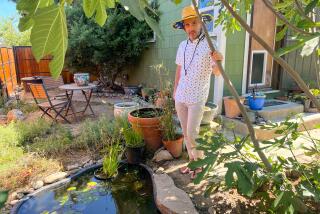A splash of spring in winter
- Share via
CALL them nature’s antidepressants: indoor plants that stave off the midwinter doldrums in a most novel way -- without so much as a scoop of soil. Placed in a simple glass container with water, the bright blooms and sculptural foliage are anchored with an eye-catching tangle of roots, laid bare for all to see.
These alternatives to cut flowers are easier to grow than one might expect. Some are bulbs forced into winter bloom; others are traditional landscape flora that have been freed from dirt and kept thriving with liquid nutrients.
One of the easiest to try is narcissus. Readily available for about a dollar apiece in garden stores and online, the humble brown bulbs produce an intensely fragrant flower with little effort. Jamie Wolf, a master gardener in Santa Monica, has forced countless bulbs, including narcissus, with the help of her staff.
“Growing narcissus is very easy to do and is a wonderful thing to see happening,” she says. “It doesn’t involve as much rigmarole as other plants.”
The process is simple and starts with finding a glass container. Sally Bartz, an accessories designer and amateur tabletop bulb gardener, likes hurricanes and taller vases.
“Narcissus start to lean when they mature, and a higher vase will support them,” she says. Shorter glass containers are fine, but the plant stems will need to be supported (twigs or bamboo work) or wrapped (raffia, twine or ribbon will do).
Next, place your bulbs in the container, using decorative rocks for stability if needed. Fill the container with water until each bulb is half submerged.
“All of a sudden, without any dirt, you have blooms in about four weeks,” Bartz says. “Every single bulb I forced this season blossomed. I had a 100% success rate.”
Those little narcissus flowers look delicate, but the sweet, musky smell can be overpowering. Wolf prefers varieties such as ‘Israel’ or ‘Galilee,’ both available from Brent and Becky’s Bulbs or other mail-order operations.
“The fragrance is more delicate and freesia-like than the varieties you find in the stores,” Wolf says.
During the Victorian era, the intensely fragranced hyacinth was a popular bulb to force during long English winters. Opinions vary on how difficult the hyacinth is to force into bloom, but when successful the result is the same: a stunning, chubby stalk choked with flowers rich in peppery-sweet fragrance.
Whereas narcissus and amaryllis bulbs can be placed in water as soon as you get them home, other bulbs such as hyacinth, tulip or glory-of-the-snow require chilling, sometimes for as long as 15 weeks. The process is worthwhile only if gardeners don’t mind the challenge and appreciate the novelty of visible roots.
“Most bulbs are not for novices,” Wolf says. “It’s a little bit like growing vegetables: Unless you are growing exotic carrots or lettuce, there isn’t a point in growing plants that are readily available at Trader Joe’s.”
BESIDES bulbs, dozens of aquatic and semi-aquatic plants do well in glass containers indoors.
Stop in Chinatown and you can pick up 2 1/2 -foot stalks of lucky bamboo for about $2 apiece from half a dozen stores. The plant is practically indestructible and comes with a colorful surprise: orange roots.
Chinese taro and calla lilies also do well in water, though you’ll probably have to purchase the plants in soil. Tap the plant out of its container, gently brush off loose dirt, then soak or spray the roots clean with filtered water. To alleviate shock, stand the plant in a pan of shallow water set in a sunless spot for a few days before moving it to its permanent home.
Nurseries and pond supply stores selling these plants and others can provide specifics for care, including the appropriate liquid nutrients needed to keep the different varieties healthy. Some other general rules of thumb:
* Metropolitan water supplies are chlorinated and fluorinated, so tap water may distress delicate roots (and leave mineral deposits on your containers). Joe Perez, pond specialist at Pro Ponds West in La Crescenta, suggests buying distilled water, saving rainwater or using a de-chlorinator, available at aquarium and pond supply stores. “Just a few drops in your vessel will do,” he says.
* Rinse the roots every week or two until new roots have formed. Change the water every week thereafter. You also can add a layer of crushed charcoal to the base of the container to help keep the water clean.
“Plants like these are cheaper than cut flowers and incredibly appealing,” Bartz says. “To have something green and alive and growing in your house, especially during this time of year, is wonderful.”






